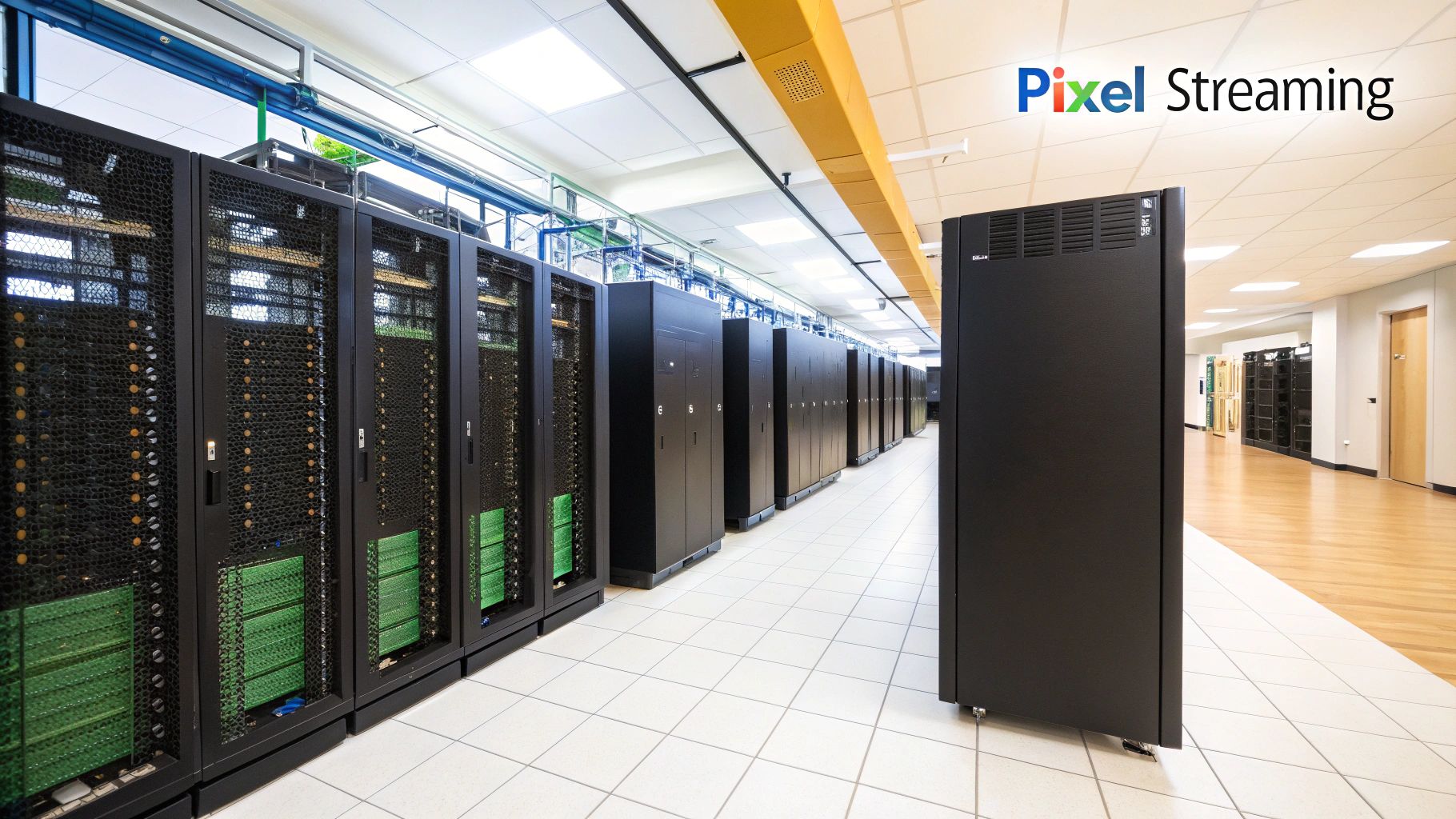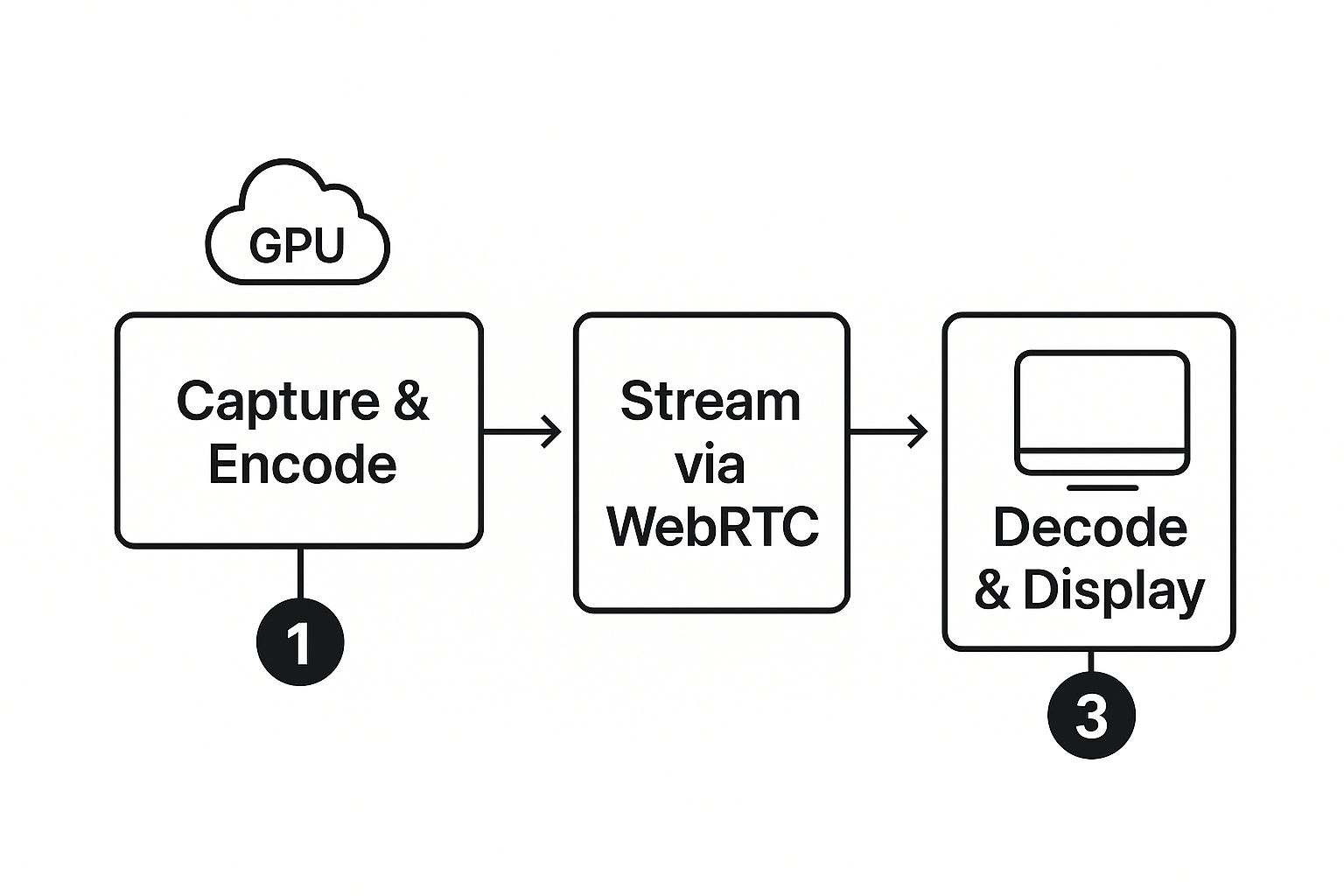Pixel Streaming Explained: The Future of Cloud Gaming
- Shrenik Jain
- Jun 22
- 13 min read
The Reality Behind Pixel Streaming's Digital Revolution
Imagine experiencing a console-quality game through nothing more than your web browser, or manipulating a complex 3D architectural model that would normally cause your laptop to freeze. This isn’t a glimpse into the future—it's the current reality of pixel streaming, a technology quietly reshaping our expectations for digital experiences. Instead of relying on your local device for heavy lifting, pixel streaming moves the workload to powerful cloud servers.

Think of it like having a supercomputer on call. Your inputs—a click, a keypress, a touch on the screen—are sent to this remote powerhouse. The server, packed with high-end GPUs, processes these commands instantly, renders the visual result, and streams it back to your screen as a high-quality video feed. This entire round-trip happens in milliseconds, creating a fluid and responsive interaction.
From Niche Technology to Mainstream Movement
This approach is fundamentally changing how we access and use sophisticated software. Tech giants are investing billions into this model, seeing its power to solve long-standing frustrations with hardware limits, massive downloads, and tricky installations. The infrastructure supporting pixel streaming is growing quickly, and you can get a clearer picture of its future by exploring the rise of cloud computing. By removing the need for users to own expensive, specialized hardware, pixel streaming makes high-end applications available to everyone.
This trend mirrors a wider shift in how we consume content. The growth of pixel streaming is directly connected to the explosion in streaming media. In fact, by 2025, streaming is expected to account for a massive 41.6% of all television viewing time, proving there is a strong preference for instant access.
The Core Principle: Separating Processing from Presentation
At its heart, the idea behind pixel streaming is simple: do the hard work somewhere else. This separation has profound implications. A design firm can share an intricate 3D building model with a client, who can then walk through it on their smartphone without a hint of lag. A software company can offer instant demos of its most demanding product directly in a customer's browser, removing barriers and speeding up sales.
This is all possible thanks to a stack of technologies working together behind the scenes:
Cloud Infrastructure: Powerful servers with dedicated GPUs handle all the rendering and complex calculations.
Real-time Encoding: The rendered frames are encoded into a video stream with almost no delay. Modern codecs like AV1 deliver much better quality than older standards like H.264, giving you sharper visuals with less data.
Low-Latency Protocols: Technologies like WebRTC ensure the video stream and your inputs travel back and forth at near-instant speed, which is essential for making the experience feel truly interactive.
This shift isn't just about convenience; it’s about making powerful tools and immersive experiences accessible to anyone with a standard internet connection. It breaks down the walls that have long kept high-performance applications reserved for a select few with the right hardware.
Inside Pixel Streaming: What Actually Happens Behind The Scenes
When you interact with a pixel streaming application, the experience feels direct and immediate, almost as if the software is running on your own computer. In reality, you're piloting a powerful remote server through a high-speed exchange that happens in milliseconds. This entire process can be broken down into three core stages: input, processing, and delivery. Each step is fine-tuned to create a fluid, interactive session.
From Your Click to the Cloud
The journey starts with your input. Every click, keystroke, or touch gesture is captured by your browser and sent as a tiny data packet to the remote server. This isn't like sending a command to a regular website; pixel streaming is built for speed. It relies on low-latency communication channels, mainly WebRTC (Web Real-Time Communication), to make sure your instructions arrive at the server with virtually no delay. Think of it as having a direct, private hotline instead of using standard mail.
This first step is crucial. Any noticeable lag here would shatter the illusion of local control, making the application feel sluggish and clunky. Modern infrastructure, including edge computing servers located closer to you, helps shrink the physical distance this data has to travel, further cutting down on what’s known as network latency.
The Server's Heavy Lifting: Rendering and Encoding
Once your input arrives, the server’s high-performance hardware gets to work. This is where the real work is done:
Application Processing: The server runs the actual application—like an Unreal Engine project—using powerful CPUs and, more importantly, high-end GPUs from NVIDIA's RTX series. Your command is fed into the application, which processes it and generates a new visual frame.
Frame Capture: The freshly rendered frame, a high-resolution snapshot of the application's current state, is captured straight from the GPU's memory.
Real-Time Encoding: This image is then compressed into a video format. This step is a careful balancing act. The server has to shrink the frame’s file size to fit your internet connection without degrading visual quality. Modern codecs like AV1 represent a significant leap forward, offering a visual quality improvement of 35-48% over the older H.264 standard at the same bitrate. This translates to sharper, cleaner visuals, even on less-than-perfect connections.
This entire sequence—receiving your input, rendering a frame, and encoding it—has to happen dozens of times every second to maintain smooth motion. To see how specific game engines manage this, check out our complete guide on Unreal Engine Pixel Streaming.
The infographic below illustrates this core workflow, showing how data travels from the server to your screen.

This visual shows the clean, three-part journey that makes real-time, remote interaction feel so natural.
The Final Mile: Streaming and Display
Finally, the encoded video frame is streamed back to your device over the same WebRTC connection. Your browser receives this video data, decodes it, and displays it on your screen. Your device isn’t doing any of the heavy rendering; it's simply acting as a sophisticated video player. This is why a basic smartphone or an older laptop can run visually stunning applications that would typically demand a top-of-the-line gaming PC.
The entire round-trip, from your click to seeing the result on your screen, is often completed in under 50 milliseconds—literally faster than the blink of an eye.
To better understand the advantages of this approach, the table below compares pixel streaming to more traditional methods of delivering and running software.
Pixel Streaming vs Traditional Content Delivery Methods
A detailed comparison showing the key differences between pixel streaming and conventional approaches in terms of hardware requirements, latency, quality, and user experience.
This comparison highlights a key takeaway: pixel streaming shifts the processing burden from the user's device to a powerful cloud server. This makes high-end experiences accessible to anyone with a decent internet connection, removing the hardware barrier that has traditionally limited interactive 3D content.
Why Businesses Are Racing to Adopt Pixel Streaming
While the theory behind pixel streaming is impressive, its true value shines when you see how companies are using it to change their daily work. Businesses are finding that this technology solves several major problems at once. It cuts IT infrastructure spending, enables global teams to work together on massive projects, and provides high-end, interactive experiences to customers on any device. This isn't just about adding a new tool; it's a strategic shift with clear financial and operational benefits.

Financial and Operational Advantages
One of the most immediate impacts is on hardware expenses. In the past, running a high-end graphical application meant every user needed a powerful computer. This resulted in huge investments in workstation-grade PCs, premium laptops, and constant upgrade cycles. Pixel streaming removes this entire burden. All the heavy lifting happens in a central, powerful data center.
Early adopters are reporting significant gains:
Hardware Cost Reduction: Many organizations see a 40-60% drop in hardware costs. They no longer need to buy expensive, high-spec machines for every employee or client.
Simplified IT Management: Instead of updating software on hundreds or thousands of individual devices, IT teams patch the application just once on the central server. This saves countless hours and guarantees everyone is always on the latest version.
Universal Accessibility: Hardware and location no longer matter. A designer in London can review a photorealistic 3D model with a client in Tokyo who is viewing it on a basic tablet. This kind of real-time collaboration was once blocked by major logistical challenges.
This new model is a major force behind market growth. Pixel streaming is fundamental to interactive cloud applications, particularly in media and entertainment. The global streaming media devices market, which relies on this technology, is expected to reach $89.48 billion by 2026.
Driving Business Growth and Sustainability
Beyond saving money, adopting pixel streaming helps companies achieve wider goals, like growth and environmental responsibility. Offering high-fidelity product demos directly in a web browser can significantly shorten sales cycles. Potential customers can try a product instantly—no downloads or installations required—removing major friction from their journey.
There's also a compelling sustainability benefit. Centralizing processing power in modern, energy-efficient data centers is much more eco-friendly than running thousands of individual, power-hungry workstations. These data centers are built for optimal cooling and power use, resulting in a much smaller carbon footprint. This helps companies make real progress on their Environmental, Social, and Governance (ESG) targets.
Choosing the right infrastructure is a crucial step. Whether a self-hosted setup or a fully managed solution is the better fit depends on your team's technical skills and business goals. For a detailed breakdown, you can explore our guide comparing self-hosted vs. managed pixel streaming to help you decide. Ultimately, the race to adopt pixel streaming is fueled by its power to make businesses more agile, accessible, and efficient.
Real Applications Transforming Industries Today
Beyond the technical details, pixel streaming is already solving real business problems across many industries. This is where theory meets reality, as companies use this technology to create engaging, accessible experiences that were once out of reach without high-end local hardware.
Interactive Product Customization and E-commerce
Imagine a car dealership where customers can design their dream car in photorealistic detail—changing colors, interiors, and accessories in real-time. This is a perfect use case for pixel streaming, as it gets rid of the need for downloads or powerful computers.
E-commerce is another area seeing a big change. Instead of just looking at static images, shoppers can now interact with a 3D model of a product, viewing it from every angle before making a purchase. The global e-commerce market, projected to reach $3,702.19 billion by 2025 with over 3.2 billion users, provides a huge stage for this technology. One e-commerce platform that added interactive 3D customization for high-end furniture saw a 45% increase in conversion rates because customers felt more confident seeing the product in a virtual space.
Advanced Training and Simulation
Pixel streaming is also making a significant impact in critical training sectors. For example, medical schools can now offer hands-on surgical simulations to students anywhere in the world. These programs let future doctors practice difficult procedures in a realistic, risk-free setting, all without needing expensive physical simulators on-site. The precise, low-latency feedback is essential for building muscle memory and sharp decision-making skills.
This same approach is changing corporate and industrial training. A major aerospace company used a pixel-streamed maintenance simulation for its technicians, which resulted in:
A 70% reduction in equipment and travel expenses.
The ability to provide consistent training to a global workforce.
A safer environment for learning hazardous procedures.
This makes advanced training tools available to more people, ensuring that skill development is no longer held back by location or budget.
Architecture, Engineering, and Construction (AEC)
In the AEC industry, being able to visualize complex projects is key. Architecture firms now host virtual building walkthroughs where clients, stakeholders, and engineers can explore a design together from anywhere. Using just their web browsers, they can make instant changes to materials, lighting, or structural elements and see the updates immediately.
A manufacturing company streamlined its international design review process in a similar way. Teams on different continents could collaborate on a complex 3D engine model, spotting flaws and suggesting improvements in a single interactive session. This replaced the slow process of sending large files and static screenshots, significantly shortening their development time.
These examples show that pixel streaming is a practical tool that delivers a clear return on investment. You can explore our case studies to see more detailed examples of how organizations are achieving measurable results. Each application demonstrates how removing the need for powerful local hardware creates new opportunities for collaboration, sales, and education.
Separating Pixel Streaming Facts From Fiction

As pixel streaming gains traction, a few persistent myths have popped up, often creating confusion for people deciding whether to adopt it. It's time to set the record straight and look at what the technology can actually deliver today. By clearing up these common misconceptions, you can make smarter choices about where it fits into your work.
One of the biggest myths is that pixel streaming requires a super-fast, enterprise-level internet connection to work. While a faster connection is always better, the reality is much more flexible. Modern streaming protocols and efficient video codecs are built to perform well on standard broadband connections—the kind most of us have at home or in the office. This accessibility is a key part of its appeal.
Another common misunderstanding is that pixel streaming is just a glorified video, like watching a movie on Netflix. This idea misses the most important element: real-time interactivity. Unlike passive video, a pixel stream is a two-way conversation. Your clicks and keystrokes are sent to the server, processed, and returned as new visual frames in milliseconds. This creates a responsive experience that a simple video feed can't match.
Debunking Common Technical Myths
Let's tackle some specific misconceptions with real data and practical examples. By comparing common assumptions to how the technology actually operates, we can get a much clearer picture.
Performance Expectations and Current Limitations
It's also important to set realistic expectations for performance. The quality of a pixel stream is always a balance between visual detail and bandwidth. A 4K stream, for instance, will naturally use more network resources than a 1080p stream. However, new video codecs are constantly improving this trade-off.
The AV1 codec, for example, delivers roughly a 35-48% improvement in visual quality over the older H.264 standard at the exact same bitrate. This means you can get sharper visuals without needing a faster internet plan. If you're building with Unreal Engine, it's worth learning how to improve pixel streaming performance with UE5 best practices, as optimizing your application at the source has a huge impact on the final experience.
Ultimately, when you cut through the hype, you see pixel streaming for what it is: a powerful and flexible tool that makes high-end interactive content available to anyone, anywhere—not a magic wand that ignores the laws of physics.
Why Industry Leaders Choose Streampixel's Approach
In the world of pixel streaming, many platforms exist, but there's often a gap between what a technology promises on paper and how it actually performs. Streampixel was built to close that gap. We provide a clear path for businesses to launch advanced interactive experiences without needing a deep bench of DevOps experts.
While generic solutions often demand heavy infrastructure investment and a complex setup process, Streampixel’s platform simplifies everything. Our focus is getting your application from the development stage to a global audience with the least amount of friction. This is built on two core principles: an obsessive focus on performance and an intelligent, automated scaling system.
A Focus on Ultra-Low Latency and Stability
The magic of a good pixel streaming experience is all about responsiveness. Any noticeable lag completely shatters the illusion that the application is running right on the user's device. Streampixel tackles this challenge directly, consistently delivering sub-50ms response times across our global network.
How do we achieve this? By running on our own purpose-built, privately owned infrastructure. This allows us to sidestep the shared resources and potential "noisy neighbor" problems common with major third-party cloud providers. By controlling the entire hardware stack—from the network all the way to the dedicated NVIDIA RTX 6000 Ada GPUs—we eliminate the variables that introduce latency. This gives developers a stable, predictable environment for their Unreal Engine applications, ensuring every user click and interaction feels instant.
Below is a look at the Streampixel dashboard, designed to be clean and straightforward for developers managing their applications.
As the image shows, the interface makes it easy to upload new builds, check session data, and view analytics, highlighting our commitment to a user-friendly workflow.
Developer-First Features
To see how Streampixel measures up against other options, let’s compare them side-by-side.
Here's a table that breaks down the key differences between a dedicated platform like Streampixel and more generic, do-it-yourself cloud solutions.
Pixel Streaming Platform Feature Comparison
Key features and capabilities comparison showing how different aspects of pixel streaming platforms stack up in terms of performance, ease of use, and scalability
This comparison highlights that Streampixel’s value isn't just about providing raw power; it's about delivering that power reliably and efficiently. The platform’s built-in analytics give you direct feedback on user behavior, helping you refine your pixel streaming strategy with real data. This combination of high-end performance, simplified management, and actionable insights is why industry leaders trust Streampixel to run their most demanding interactive applications.
Your Strategic Path Into Pixel Streaming Implementation
Moving from curiosity about pixel streaming to a real-world deployment requires a smart, step-by-step plan. The first thing you need to do is nail down your most important use case. Are you trying to make your customer demos more interactive? Do you want to let teams collaborate on complex 3D models from anywhere? Or are you aiming to launch a new kind of digital product? Your answer will guide every decision you make from here on out.
Instead of trying to transform your entire company at once, the key is to start with a focused pilot program. A great pilot solves a specific problem for a single team. This approach proves value quickly, gets key people on board, and keeps initial risks low. By starting small, you create a compelling internal success story that makes it easier to argue for a wider rollout.
Building Your Implementation Framework
With a target application in mind, the next step is to figure out if your organization is ready and what a "win" actually looks like. This doesn't have to be a massive undertaking, but a little planning goes a long way.
Here’s a simple framework to guide your thinking:
Define Success Metrics: What concrete results will prove your pilot was worth it? This could be something like shortening the sales cycle by 15% with interactive demos or cutting costs on physical prototypes. Make sure these goals tie back to what your business cares about.
Assess Current Infrastructure: Take a look at your existing network and the devices your users have. While pixel streaming is built to work over standard internet connections, knowing your baseline helps you set realistic expectations for performance.
Evaluate Vendor Solutions: Not all platforms are the same. Compare different providers based on latency, how easily they can scale, the quality of their developer support, and their pricing. Find a partner who gets your industry and its unique challenges.
Establish a Realistic Timeline: Break the project down into smaller, manageable chunks: initial setup, integrating your application, user testing, and the full pilot launch. A clear timeline keeps everyone on the same page and the project moving forward.
Common Pitfalls and How to Avoid Them
Learning from those who have gone before you can help you sidestep common problems. A major oversight is underestimating security. As you map out your strategy, it’s crucial to build in strong security measures from the start. Following well-established web application security best practices is essential to protect your stream. Another common mistake is poor communication with stakeholders, which often leads to confusion about performance or deadlines.
By understanding both the opportunities and the potential hurdles, you can make smarter decisions. This measured approach ensures your first dive into pixel streaming isn't just a technical test, but a calculated business move that delivers real, measurable results.
Ready to bring your Unreal Engine applications to a global audience with unparalleled ease and performance? Streampixel offers a secure zero-setup, ultra-low latency platform built for developers. Start your project today and see how simple it is to stream demanding interactive experiences directly in any web browser.